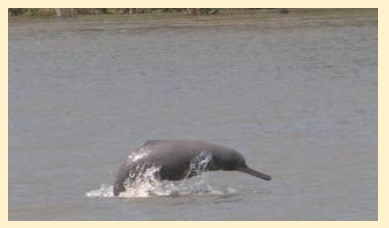Ganga River Dolphins
Ganga River Dolphins
Scientific name of Ganga river dolphins: Platanista gangetica gangetica
Unique Features
Body: Sturdy but flexible body with large flippers and low a triangular dorsal fin. Weighs up to 150 kg.
Color: Calves are chocolate brown at birth and adults are greyish brown.
Head: Head melon shaped with a long thin snout armed with as many as 130 sharp teeth. A slit like blowhole on the top of the head, acting as a nostril. From teeth long and sharp, lower law longer than the upper jaw.
Skin: Smooth and hairless.
Size: Female is larger than male. Maximum size of female- 2.67m and male – 2.12m.
Habitat: Prefers deep waters, In and around the confluence of two or more rivers. Shares its habitat with crocodiles, freshwater turtles and wetland birds.
Feeding habits: Normally chases surface dwelling fishes and grovels mud dwelling fishes in shallow water with the help of their long snout.
Breeding: Female attains sexual maturity at an age of 10-12 years, male matures earlier. The gestation period is 9-11 months and a female gives birth to only calf, once in 2-3 years.
Ganga river ecosystem
Rich biodiversity in a river ecosystem is the ultimate indicator of the river’s health. Ganga river ecosystem has rich biodiversity. However due to increasing pressures on the river for economic and commercial reasons and excessive unfair human interventions has resulted in increased pollution and insufficient flows that has further ushered the depletion of natural habitats and disturbed the food chain for the riverine biodiversity. This has serious consequences on the biodiversity of the river system and subsequently River Ganga for quite some time has almost lost
some of its very important species such as Ganga River Dolphins (Platanista gangetica gangetica), Gharials (Gavialis gangeticus), etc. which have to be placed in endangered category under Schedule I of the Indian Wildlife Protection Act 1972.
One of such nearly extinct species is the Ganga River Dolphin, also known as Souns or Susu, Sushuk or Seho, which is found in the Ganga river system including its tributaries like Ghagra, Chambal, Gandak, and Kosi as well as in Brahmaputra river system. Its status of existence has become a matter of serious concern over the past few decades as this is an indicator species of health of the river ecosystem. Population estimates of Gangetic Dolphins reported by various
experts is around 1800-2000 individual. The migration of Gangetic dolphin depends upon river water level, during dry season many dolphins leave the tributaries of the Ganga and Brahmaputra systems and congregate in the main channels.
Major Threats
- Habitat loss /Degradation / Disturbances – Annual flood, etc.
- Changing River course.
- Inland waterways / Movement of large cargo vessels.
- Various anthropogenic / religious activities.
- Excessive harvesting/hunting/food – subsistence use/ local trade.
- Directed killing/ poaching.
- Accidental killing – by catch/ fisheries related entanglements.
- Accidental mortality – others.
- Water pollution – Agriculture related – on both the banks of River/chemical.
- Water pollution – domestic / direct disposal of sewage / non-functional treatment plants.
- Pollution – affecting habitat and/ or species, Industrial effluents.
Conservation Initiatives activated by the Government of India
- Declared the Ganges River Dolphin as National Aquatic Animal on 10th May 2010 as recommended in the first meeting of NGRBA.
- A working group was formed to prepare conservation action plan for Gangetic River Dolphin.
- An action plan implementation Advisory Committee.
- Dolphin Awareness Program (Phase - I) has been completed. Further strengthening of networking is being taken up in Phase- II with NGOs, schools and teachers in Ganga and Brahmaputra river basins.
- In the upper Ganga. 164 kms stretch of dolphin habitat is under monitoring to minimize potentials threats.
National Mission for Clean Ganga (NMCG) in its efforts of biodiversity conservation in Ganga River basin has been working further on the Ganges River Dolphin Conservation Action Plan and has taken up steps to coordinate with various institutions to:
- build capacity for Ganga River Dolphin Conservation and Management;
- minimize fisheries interface and incidental capture of Ganga River
- Dolphins;
- restore river dolphin habitats by minimizing and mitigating the impacts of
- developmental projects;
- involve communities and stakeholders for sustainable efforts in Ganga River
- Dolphin conservation;
- educate and create awareness and
- Set off targeted research.
Source: NMCG
Last Modified : 2/27/2020
